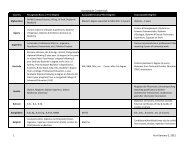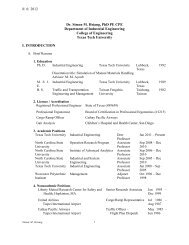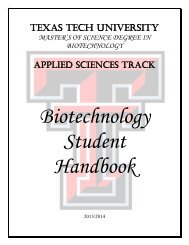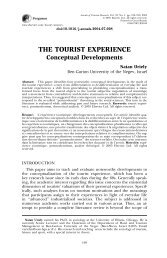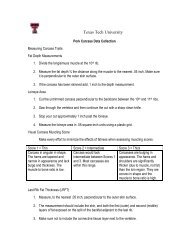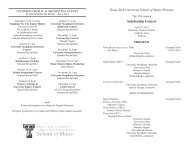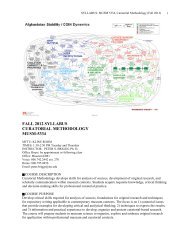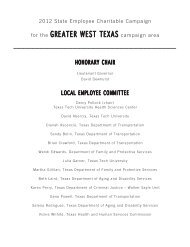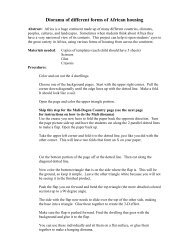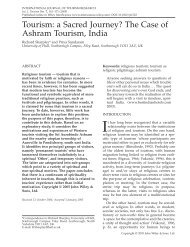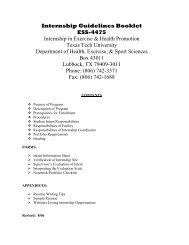Farm animal welfare in the context of other society issues: toward ...
Farm animal welfare in the context of other society issues: toward ...
Farm animal welfare in the context of other society issues: toward ...
Create successful ePaper yourself
Turn your PDF publications into a flip-book with our unique Google optimized e-Paper software.
80 J.J. McGlone / Livestock Production Science 72 (2001) 75 –81<br />
Fig. 2. Model <strong>of</strong> how <strong>animal</strong> <strong>welfare</strong> and its components must fit with<strong>in</strong> <strong>the</strong> framework <strong>of</strong> susta<strong>in</strong>able production systems.<br />
works that o<strong>the</strong>rwise might not have surfaced. Fur- Council for Agricultural Science and Technology, 1997. The<br />
<strong>the</strong>rmore, <strong>the</strong> multidiscipl<strong>in</strong>ary research approach Well-be<strong>in</strong>g <strong>of</strong> Agricultural Animals. Council for Agricultural<br />
Science and Technology, Ames, Iowa. USA.<br />
must be considered with<strong>in</strong> <strong>the</strong> <strong>context</strong> <strong>of</strong> o<strong>the</strong>r<br />
Curtis, S.E., 1985. What constitutes <strong>animal</strong> well-be<strong>in</strong>g. In:<br />
<strong>society</strong> <strong>issues</strong> <strong>in</strong>clud<strong>in</strong>g protection <strong>of</strong> <strong>the</strong> environ- Moberg, G.P. (Ed.), Animal Stress. American Physiological<br />
ment, <strong>the</strong> workers, farm <strong>in</strong>come, community and Society, Be<strong>the</strong>sda, MD, pp. 1–14.<br />
national health and food safety. To be able to make Dawk<strong>in</strong>s, M., 1976. Towards an objective method <strong>of</strong> assess<strong>in</strong>g<br />
such complex comparisons will require truly mul- <strong>welfare</strong> <strong>in</strong> domestic fowl (treatment <strong>of</strong> <strong>animal</strong>s, behavior).<br />
tidiscipl<strong>in</strong>ary teams that <strong>in</strong>clude scientists, econom- Appl. Anim. Ethology 2, 245–254.<br />
Duncan, I.J.H., 1993. Welfare is to do with what <strong>animal</strong>s feel. J.<br />
ists and sociologists with a strong dose <strong>of</strong> reality.<br />
Agric. Environ. Ethics 6 (Suppl. 2), 8–14.<br />
Some nations might want to consider <strong>the</strong>ir national Ewbank, R., 1985. Behavioral responses to stress <strong>in</strong> farm <strong>animal</strong>s.<br />
resources and local environments and determ<strong>in</strong>e if In: Moberg, G.P. (Ed.), Animal Stress. American Physiological<br />
each segment <strong>of</strong> <strong>animal</strong> agriculture can be susta<strong>in</strong>ed Society, Be<strong>the</strong>sda, MD, pp. 73–79.<br />
while protect<strong>in</strong>g <strong>the</strong> health <strong>of</strong> <strong>the</strong> <strong>animal</strong>s and <strong>the</strong> Fraser, A.F., 1980. Ethology <strong>welfare</strong> and preventive medic<strong>in</strong>e for<br />
livestock. Appl. Anim. Ethology 6, 103–109.<br />
people.<br />
Gonyou, H.W., 1986. Assessment <strong>of</strong> comfort and well-be<strong>in</strong>g <strong>in</strong><br />
farm <strong>animal</strong>s. J. Anim. Sci. 62, 1769–1775.<br />
Hughes, B.O., 1973. Animal <strong>welfare</strong> and <strong>the</strong> <strong>in</strong>tensive hous<strong>in</strong>g <strong>of</strong><br />
Acknowledgements<br />
domestic fowls. Vet. Rec. 93, 658–662.<br />
McGlone, J.J., 1993. What is <strong>animal</strong> <strong>welfare</strong>? J. Agric. Ethics 6,<br />
26–36.<br />
I would like to thank <strong>the</strong> USDA for its support <strong>of</strong> McGlone, J.J., Salak-Johnson, J.L., Nicholson, R.I., Hicks, T.,<br />
research <strong>in</strong> <strong>the</strong> area <strong>of</strong> farm <strong>animal</strong> well-be<strong>in</strong>g. 1994. Evaluation <strong>of</strong> crates and girth te<strong>the</strong>rs for sows: reproductive<br />
performance, immunity, behavior and ergonomic mea-<br />
Program support is from CSREES, ARS and The<br />
Fund For Rural America programs to <strong>the</strong> author. The sures. Appl. Anim. Behav. Sci. 39, 297–311.<br />
Moberg, G.P., 1987. A model for assess<strong>in</strong>g <strong>the</strong> impact <strong>of</strong><br />
American Society <strong>of</strong> Animal Science contributed to<br />
behavioral stress on domestic <strong>animal</strong>s. J. Anim. Sci. 65, 1228–<br />
travel to <strong>the</strong> 2000 EAAP meet<strong>in</strong>g. 1235.<br />
Morrow-Tesch, J.L., McGlone, J.J., Salak, J.L., Hurst, R.J., 1994.<br />
Heat and social stress effects on pig leukocyte numbers,<br />
mitogen-<strong>in</strong>duced lymphocyte proliferation, antibody syn<strong>the</strong>sis<br />
References and plasma immunoglobul<strong>in</strong> G concentration. J. Anim. Sci. 72,<br />
2599–2609.<br />
Barnett, J.L., 1987. The physiological concept <strong>of</strong> stress is useful Robert, S., Rushen, J., <strong>Farm</strong>er, C., 1997. Both energy content and<br />
for assess<strong>in</strong>g <strong>welfare</strong>. Aust. Vet. J. 64, 195–196.<br />
bulk <strong>of</strong> food affect stereotypic behaviour, heart rate and<br />
Broom, D.M., 1991. Animal <strong>welfare</strong>: concepts and measurement. feed<strong>in</strong>g motivation <strong>of</strong> female pigs. Appl. Anim. Behav. Sci. 54,<br />
J. Anim. Sci. 69, 4167–4175. 161–171.



